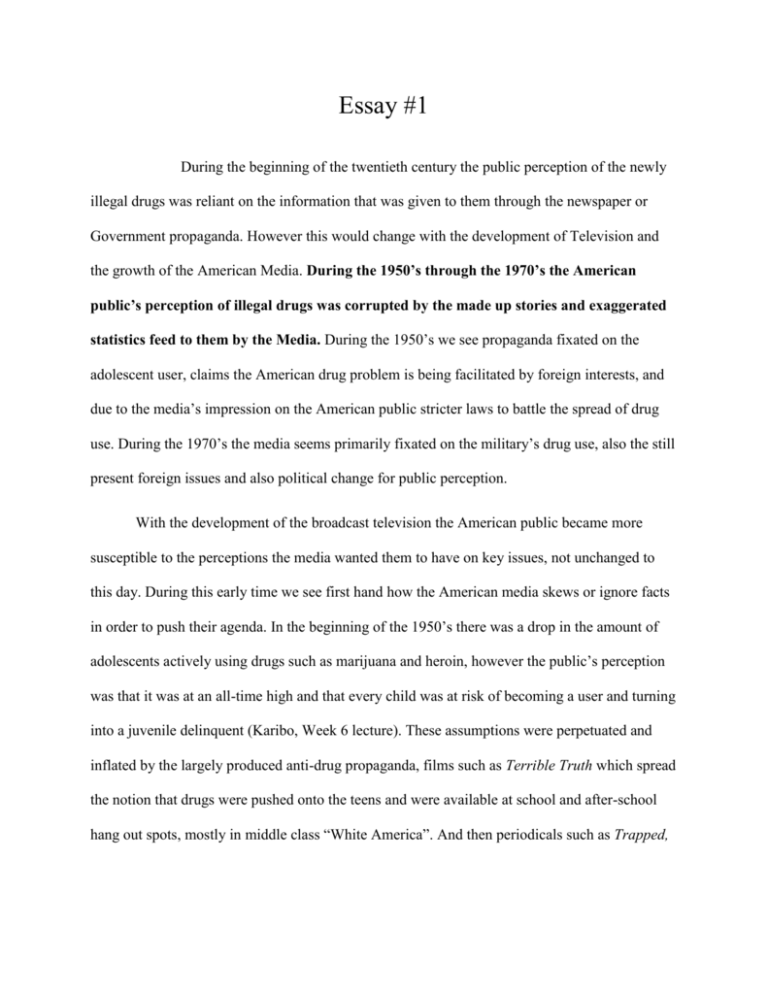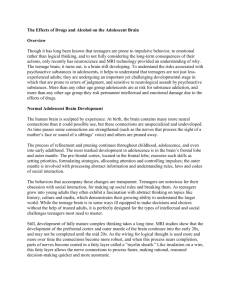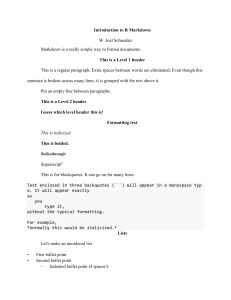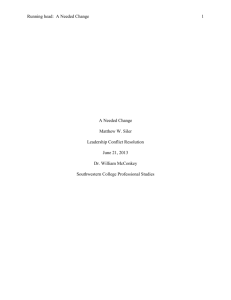modual 2
advertisement

Essay #1 During the beginning of the twentieth century the public perception of the newly illegal drugs was reliant on the information that was given to them through the newspaper or Government propaganda. However this would change with the development of Television and the growth of the American Media. During the 1950’s through the 1970’s the American public’s perception of illegal drugs was corrupted by the made up stories and exaggerated statistics feed to them by the Media. During the 1950’s we see propaganda fixated on the adolescent user, claims the American drug problem is being facilitated by foreign interests, and due to the media’s impression on the American public stricter laws to battle the spread of drug use. During the 1970’s the media seems primarily fixated on the military’s drug use, also the still present foreign issues and also political change for public perception. With the development of the broadcast television the American public became more susceptible to the perceptions the media wanted them to have on key issues, not unchanged to this day. During this early time we see first hand how the American media skews or ignore facts in order to push their agenda. In the beginning of the 1950’s there was a drop in the amount of adolescents actively using drugs such as marijuana and heroin, however the public’s perception was that it was at an all-time high and that every child was at risk of becoming a user and turning into a juvenile delinquent (Karibo, Week 6 lecture). These assumptions were perpetuated and inflated by the largely produced anti-drug propaganda, films such as Terrible Truth which spread the notion that drugs were pushed onto the teens and were available at school and after-school hang out spots, mostly in middle class “White America”. And then periodicals such as Trapped, Holiday of Horrors and Dope Inc all were made to scare kids and adolescents away from drugs rather than properly inform them (Schneider, p.55). Post World War II America was very scared of communists and the media exploited this fear also. Thanks to the Federal Bureau of Narcotics the main suppliers of drugs into the veins of American adolescents were communists China and Organized Crime (Schneider, p.66). Large amounts of Chinese opium did travel to America, however the amount would soon drop drastically after the Nationalists of China were expelled from the mainland, a fact that was ignored by the FBN due to China’s communist ties to the Cold War. Additionally much of the public was convinced of these facts to be true due to the hearing them at public hearings, reading them in newspapers and magazines and the leaking of evidence by the FBN. By using the children of middle class Americans as “pawns” in anti-drug propaganda via media outlets the federal government would pass two Congressional acts one in 1951 and the other in 1955. The first one was the Boggs Act which was the first to create a minimum sentence for drug possession, however it was only 2-5 years (Schneider, p.73) The second was the Narcotic Control Act which increased the minimum sentence to 5-20 years and added the death penalty for those arrested for selling drugs to kids (Karibo, week 6 lecture). By the 1970’s drugs in the media was still unchanged, the only difference was this time the media was going against what the Federal Government was claiming to be accurate in order to keep the public’s perception on drugs in America. A 1970 Government report on drug use by American GIs station near Cambodia showed that only 5.5% were users, however this figures were exaggerated and blown up by reporting journalists making claims that upwards of 60-90% of American GIs stationed in Vietnam were drug users (Kuzmarov, p.347,348). By using terms such as epidemic and plague reporters altered the public’s perception of the returning soldiers into one of fear. This would also influence President Nixon to abandon the practice of traditional abstinence from drugs for the more successful Methadone clinics as a solution to a panicking public (Schneider, p.159). additionally the media propaganda used on the American GIs failed due to the traditional tactic of scaring them away from the drugs, whereas many of them already tried marijuana and lived so it caused them to question the truthfulness to the claims on other drugs (Schneider, p.160). The American GIs were also aware that the reporting media was making false reports of their drug use and making them all seem like drug abusers (Kuzmarov, p.347). Media coverage of illegal drugs in America widely influenced the perception of middle and upper class Americans by inflating statistics and using scare tactics. During the 1950’s the issue was drugs influencing the youth of America, and turning them into juvenile delinquents. And in the 1970’s the issue was drug addicted soldiers, and the threat they posed to the increase in criminal activity. Essay #2 During the 1960’s Americans saw an increase in the use of illegal substances, which was mostly by young adults. The demographics of the using community expanded to more than those in urban cities, the culture evolved into one of open and experimental, and to one of limitless financial gain. These changes occurred due to changes in social expectations, alternative political views to that of ones patents and the change in the community’s economical standing. In the 1960’s the children of World War II or also known as the Baby Boom generation was reaching adolescents and held a different opinion on illegal drugs than that of their parents (Karibo, Week 6 lecture). This group of youth were flocking to bohemian or hippy areas, most popular were Heights Ashbury in San Francisco and Greenwich Village in New York (Schneider, p.142). This group would be referred to as the Counter Culture (Karibo, week 6 lecture), and while living in or visiting these communities they would be exposed to a wide array of drugs from the typical marijuana and heroin to other drugs such as LSD, hallucinogens and amphetamines (Schneider, p.142). The beats of the 1930’s and 1940’s were small in numbers by the time the suburban white youth migrated into the counter culture communities, however their reputation made them the most influential by introducing the naive youth to new drugs (Schneider, p. 143). Despite this mixing of different youths in the urban cultural centers there was still a distinct difference in drug preference between the ethnic groups. White and middle class youths started with Marijuana and would progress to Hallucinogens and Amphetamines, whereas African American and Latino youths would, similarly, start with Marijuana they would progress to using Heroin and Cocaine (Karibo, week 6 lecture). The bohemian drug culture was open and explorative, going against the values of their parents, (social integrations, political anarchism and sexual/drug experimentation) and explored the world for themselves. This new generation was changing in the way that they saw society, be this due to the drugs or their cultural openness, more and more were seeing the errors in the social norm of America. During the 1960’s there is an increase in youth awareness of political issues and formation of protests and marches. The increasing bohemian culture joined in the fight for civil rights, and held protests both for civil rights and against the Vietnam War. Additionally they were increasing in their environmental awareness (Karibo, week 6 lecture), the introduction of “go green” sustainability. With the stricter narcotic laws passed in the 1950’s it opened a widely available black market for drugs, suburban youths saw for opportunity to rebel against authority. Prior to the migration of the white youth to the urban cultural centers, the economical progression of their parents allowed for them to move out of the urban cities and into suburban communities this was also referred to as the “White Flight” (Karibo, Week 6 Lecture). The dramatic change in the social demographic of urban cities amounted to a population of 40-70% nonwhite adolescents living in the urban cities (Karibo, week 6 lecture). Not only did this change the social standing of the urban cities, however it also altered the economical standing. Adolescent minorities did not have many opportunities for high wages through legitimate employment, however they saw the opportunity to make substantially more money in selling drugs (Bourgois, P.7). Open markets for drug sales and corruption within the urban police, notably the NYPD, and the Federal Bureau of Narcotics (Karibo, week 6 lecture) only helped in the growth and allure of dope dealing to the youth. Furthermore the occupation of dope dealing became somewhat easier with the new channels of smuggling through air travel which make it difficult to track (Karibo, week 6 lecture). In the 1960’s a dramatic change occurred in the drug using community and to the culture of drug users. The increase in white middle class youths helped shift the social, political and economic aspects of drug use in America. A wide variety of drugs were being experimented with and an open acceptance of all social classes was developing. Additionally this influx of customers increased the demand for illegal drugs in urban neighborhoods, which would increase the urban adolescents desire to become a dope dealer.







